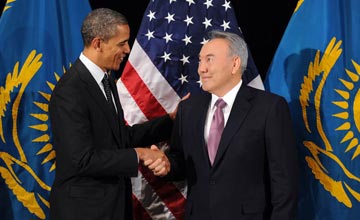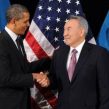
Economic and Social Programs Are Underway in Zhanaozen
Publication: Eurasia Daily Monitor Volume: 9 Issue: 62
By:

As the trials against 37 people for organizing and participating in the December Zhanaozen riots are starting in Aktau on March 27, the Kazakh authorities continue implementing a comprehensive program to mitigate the core reasons for the conflict, prevent social tensions in the future, and improve living conditions in this one-industry city. Government efforts to normalize the situation in Zhanaozen have been apparently noted by US President Barak Obama during his meeting with Kazakh President Nursultan Nazarbayev on the sidelines of the Nuclear Security Summit in Seoul on March 26 (Presidential Press Service; Interfax, March 26).
However, the events in Zhanaozen raised the question whether a wave of social unrest could sweep all of Kazakhstan and destabilize the country. According to an opinion survey conducted by the Almaty-based Institute for Political Solutions, 38 percent of Kazakhs think that Zhanaozen-like events may happen in other towns. Every fifth respondent rejected such a possibility, but the largest number made up the people who could not answer the question (43.3 percent). According to the report, most of the respondents agreed with the measures the authorities have taken to stabilize the situation. The poll indicates that 42 percent of the interviewed assess the current situation in Zhanaozen as stable, 24 percent as tense, and 6.2 percent believe that the situation is explosive. The survey was carried out in 14 regional centers and the cities of Astana and Almaty in mid-February (Interfax-Kazakhstan, March 11).
The deadly incidents in Zhanaozen and Shetpe were unprecedented in the recent history of Kazakhstan, while the circumstances that led to the clashes between rioters and police were unique and complex. The firing of over 2,000 striking oil workers by the local oil company OzenMunaiGas and the ignorance of the local administration contributed to turning a labor dispute into a riot. The town’s oil workers have been striking for higher pay and better working conditions for three years in a row, although their pay is 50 percent higher than the average salary in Kazakhstan. Even though workers’ demands had been satisfied in previous strikes, in May 2011 both the oil company management and the trade unions failed to engage in productive negotiations. The town’s declining oil reserves, combined with a rapidly growing population, a harsh semi-desert climate (with extremely cold winters and unbearable summer heat) and insufficient infrastructure development, further exacerbated the conflict (EDM, January 17). Finally, the response of the police, which used lethal weapons against the protestors because they lacked adequate riot control equipment and suitable training, raised questions about police practices and insufficient police reform.
One of the reasons behind the labor conflict and the subsequent rioting were inadequate migration policies, said the governor of Mangistau region, Baurzhan Mukhamedzhanov. Thousands of “oralman” – ethnic Kazakhs from other countries – have repatriated to Kazakhstan in the last two decades and disproportionately settled in Zhanaozen. Since 1975, the population has increased six times from 20,000 to 120,000, a process that has been particularly intense in the last two decades since independence. In the meantime, oil production has dropped six fold to 6 million tons per year. In addition, Zhanaozen has the highest birth rate in Kazakhstan resulting in thousands of young people who have difficulties finding jobs (Interfax-Kazakhstan, March 12, author’s interviews in Zhanaozen).
The ongoing economic and social program for Zhanaozen has three tracks: opening new jobs in the oil industry, stimulating small business development, and improving the city’s infrastructure. KazMunaiGas Exploration Production (KMG EP) announced that 2,010 former employees of OzenMunayGas and Karazhanbasmunay, subsidiaries of the state-owned KazMunaiGas, have been offered new jobs (Interfax, March 12). KMG EP has allocated 20 billion tenge ($1.35 billion) to establish two new production companies, purchase equipment, and create jobs for redundant oil workers. Transport and Well Servicing Business Unit LLP will be created in Aktau, and Drilling and Well Servicing Business Unit LLP will start operations in Zhanaozen. Under the special program of Zhanaozen development, the national welfare fund Samruk-Kazyna, which owns KazMunaiGas, is working on 16 projects including oilfield equipment repair services, a mini oil refinery, an oil loading terminal and a ship repair yard.
In an effort to prevent any escalation of future labor disputes, Samruk-Kazyna started a series of training seminars for senior executives, department heads, and human resources managers. The conflict in Zhanaozen showed that both managers and trade-union leaders lack understanding of the labor laws and do not use the tri-partite mechanism for negotiations in such occasions. “We have learned a serious lesson from the events in Mangistau region. We should be ready to use new methods to resolve labor disputes. I want to implement systemic measures to prevent labor conflicts,” the new head of Samruk-Kaziyna Umirzak Shukeyev told the 7th International Conference on Human Resources Management in Astana on March 1.
Mangistau governor Baurzhan Mukhamedzhanov has warned, however, that the oil sector cannot provide enough jobs for everyone. He has advised Zhanaozen residents to abandon their welfare mentality and engage in entrepreneurship to improve their living standards. The government has compensated business owners who suffered damages from arson and looting during the riots and provided low interest loans to local small businesses to stimulate development. In addition, city financing has been increased by 7 billion tenge to 46 billion. This year alone, 15 billion tenge will be injected in the development of social and recreational infrastructure in the city (Interfax-Kazakhstan, March 12). Zhanaozen is 150 kilometers away from the closest city Aktau where young people can enjoy entertainment, such as cinemas, theaters and disco-clubs.
As the economic and social programs in Zhanaozen are under way, the Ministry of Internal Affairs of Kazakhstan announced plans to equip its riot police units with non-lethal means of restraint. The national budget will assign funds for such equipment in 2013-2015 (Interfax-Kazakhstan, February 16). Police reform in Kazakhstan has been lagging behind the country’s rapid economic growth; the lack of transformation of the police force has become a major obstacle to building a true civil society in the country.




